#514 Supernova Remnant and Neutron Star November 14, 1996
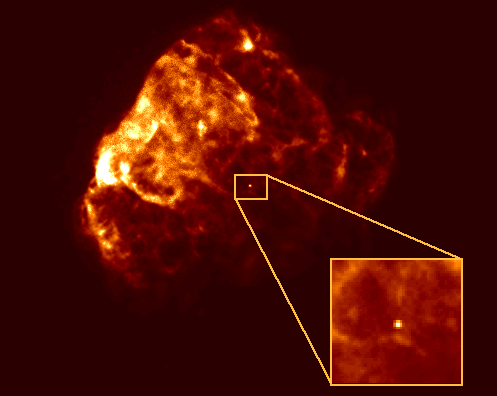
“A massive star ends life as a supernova, blasting its outer layers back to interstellar space. The spectacular death explosion is initiated by the collapse of what has become an impossibly dense stellar core. However, this core is not necessarily destroyed. Instead, it may be transformed into an exotic object with the density of an atomic nucleus but more total mass than the sun - a neutron star. Directly viewing a neutron star is difficult because it is small (roughly 10 miles in diameter) and therefore dim, but newly formed in this violent crucible it is intensely hot, glowing in X-rays. Images from the ROSAT X-ray observatory above may offer a premier view of such a recently formed neutron stars' X-ray glow. Pictured is the supernova remnant Puppis A, one of the brightest sources in the X-ray sky, with shocked gas clouds still expanding and radiating X-rays. In the inset close-up view, a faint pinpoint source of X-rays is visible which is most likely the young neutron star, kicked out by the asymmetric explosion and moving away from the site of the original supernova at about 600 miles per second."
Copyright: Public domain
#515 Searching For Solar Systems November 15, 1996
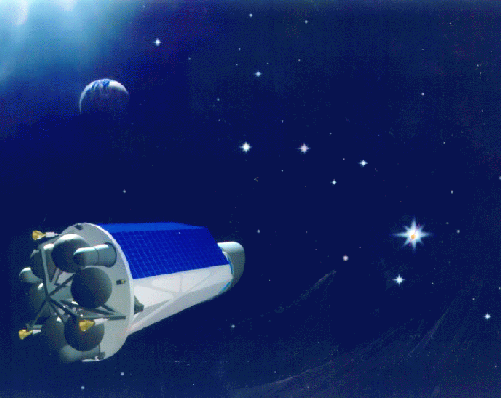
“Observational astronomy has recently provided evidence of the existence of massive Jupiter-sized planets orbiting distant suns, protoplanetary disks of gas and dust surrounding newly formed stars, and planetary bodies orbiting exotic stellar corpses known as pulsars. Indeed, the formation of planets seems to be a broader and more varied phenomenon than previously imagined. Are there nearby solar systems with Earth-sized planets as well? Many would answer yes, but small, relatively low mass planets orbiting sunlike stars - which might be capable of supporting life - are extremely difficult to detect. One possible approach to this daunting observational problem is to regularly monitor the light from many solar-type stars, searching for the slight decrease in brightness which signals the transit of a small planet in front of the stellar disk. A proposal for a space-based instrument to engage in such a program, the Kepler Mission, is illustrated above. In this concept, the monitoring space telescope orbits the Sun, slowly drifting away from Earth. The goal of this mission would be to discover Earth-sized planets in the habitable zone of solar-type stars, taking a step toward answering the profound question - Does life exist on other worlds beyond our Solar System? Watch the Leonid Meteor Shower this weekend!"
Copyright: Public domain
#516 The Leonid Meteor Shower (Tonight)
Credit: November 16, 1996
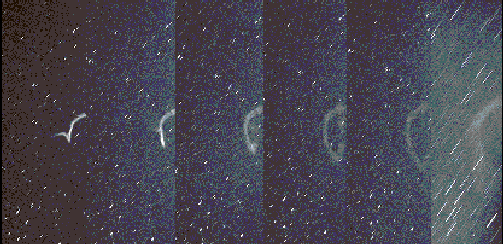
“Tonight thousands of icy rocks will hurl toward Earth in a fascinating display of light called the Leonid Meteor Shower. There is little danger - few will reach the ground. But this year's Leonids could be nothing compared to the Leonids in 1998. Then, the Leonids might rival any meteor storm this century, with peak rates possibly toping 40 per second. Meteor showers result from debris left by passing comets. The Leonids specifically are small pieces of Comet Tempel-Tuttle. In the above series of time-lapse, 1-minute exposures, a 1995 Leonid is seen to leave a train of hot air that glowed persistently for several minutes. "
Copyright: Public domain
#517 A Quasar in the Gamma-Ray Sky November 17, 1996
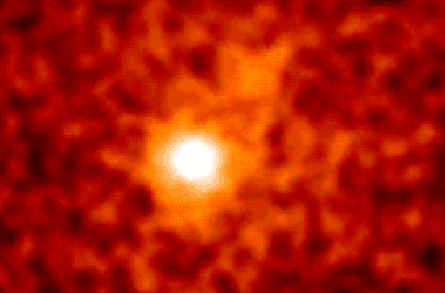
“The bright object in the center of the false color image above is quasar 3C279 viewed in gamma-rays, photons with more than 40 million times the energy of visible light. Like all quasars, 3C279 is a nondescript, faint, starlike object in the visible sky. Yet, in June of 1991 a gamma-ray telescope onboard NASA's orbiting Compton Gamma Ray Observatory unexpectedly discovered that it was one of the brightest objects in the gamma-ray sky. Shortly after this image was recorded the quasar faded from view at gamma-ray energies. Astronomers are still trying to understand what causes these enigmatic objects to flare so violently. Another quasar, 3C273, is faintly visible above and to the right of center."
Copyright: Public domain
#518 Unusual M82: The Cigar Galaxy
Credit and Copyright: November 18, 1996
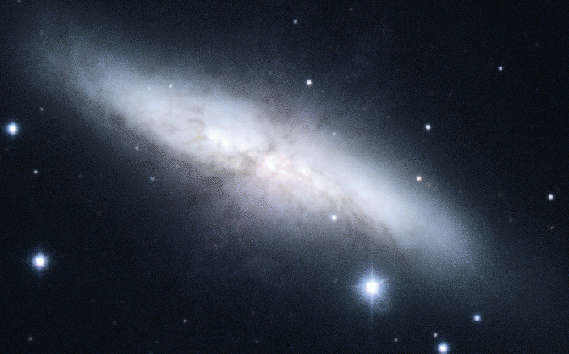
“Something strange happened to this galaxy, but what? M82 is a nearby galaxy in the group of galaxies dominated by itself, M81, and NGC 3077. M82 is thought by some to be limping away from a close encounter with M81. This galactic collision might have stirred up the inner stars and gas in M82, causing the unusual dark lanes of dust visible in the above photograph. M82 is a starburst galaxy with a very active center containing star clusters far brighter than any in our own Milky Way Galaxy. "
Copyright: Public domain
#519 Fractal Interstellar Dust Up-Close
Credit and Copyright: November 19, 1996
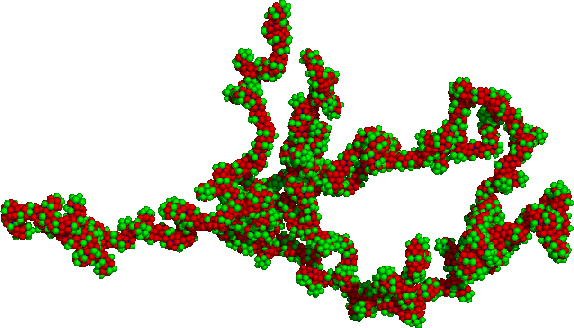
“Our universe is a very dusty place. Dust usually shows its presence by blocking out light emitted from stars or nebula behind it, sometimes creating the illusion of a horse's head or a sombrero hat. But nobody really knows what a typical interstellar dust grain looks like. By studying how dust absorbs, emits, and reflects light, astronomers do know that interstellar dust is much different than the cell and lint based dust found around a typical house. Interstellar dust grains are composed mostly of carbon, silicon, and oxygen and are usually less than about 1/1000 of a millimeter across. Recent work indicates that most dust grains are not spherical. The above picture shows the result of a fractal adhesion model for dust grains involving random conglomerates of spherical compounds of different properties, here artificially highlighted by different colors. "
Copyright: Public domain
#520 Europa Full Face
Credit: November 20, 1996
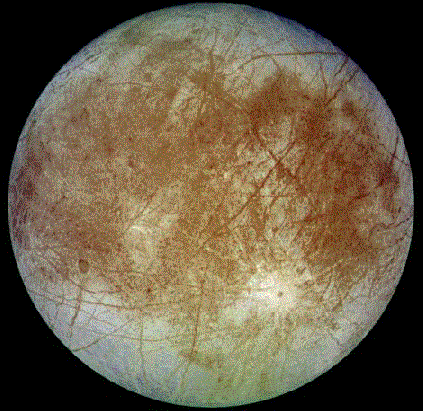
“What mysteries might be solved by peering into this crystal ball? This crystal ball is quite unusual because it is actually a moon of Jupiter, the crystals are ice-crystals, and the ball is not only dirty and opaque but cracked beyond repair. Nevertheless, speculation is rampant that oceans exist under these tortured ice-plains that could support life. Europa, the smallest of Jupiter's Galilean moons, was photographed last month in natural color by the robot spacecraft Galileo, now in orbit around Jupiter. The brown patches are what one might think: dirt -- tainting an otherwise white ice-crust. Europa, nearly the same size as Earth's Moon, similarly keeps one face toward its home planet. The hemisphere of Europa shown above is the one that always trails. Why is Europa's surface the smoothest in the Solar System? Where are Europa's craters? "
Copyright: Public domain
#521 The Blue Snowball Planetary Nebula
Credit: November 21, 1996
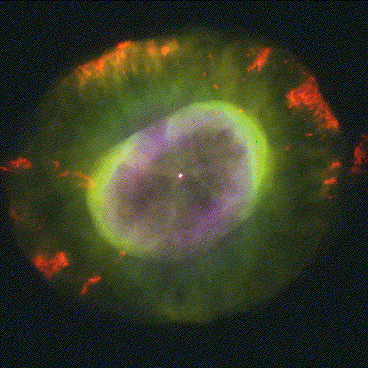
“Will the Sun one day look like - a blue snowball? Maybe! The Blue Snowball is a planetary nebula - and in 5 billion years the Sun will throw off its outer layers and go through a planetary nebula phase. A star can appear "normal" only so long as there are sufficient nuclear reactions in its core. Soon thereafter, gravity will win out and compress the stellar core to higher temperatures. Eventually the core becomes a white dwarf. These high temperatures somehow cause the expulsion of star's outer layers, creating a planetary nebula such as the Blue Snowball pictured above. Although the Blue Snowball, also known as NGC 7662, does appear blue, the above picture's colors are not real and were chosen to highlight the emission of certain ions in the nebula. Many things are still not known about planetary nebula, including details of the physical mechanism that creates the nebula, and the reason for fast knots of gas in the outer regions known as fliers. "
Copyright: Public domain
Upvote! Resteem! Comment! As you like it! Thank you for attention!